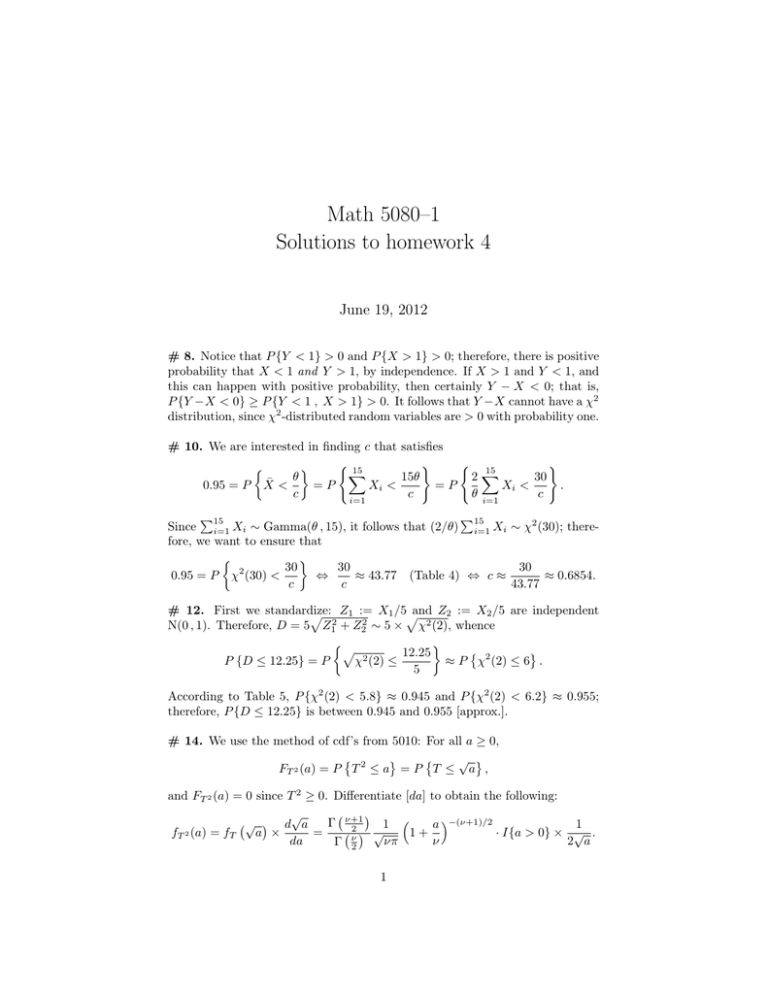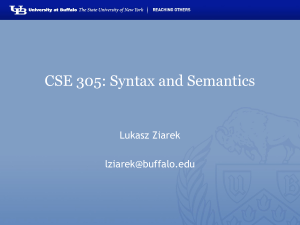Math 5080–1 Solutions to homework 4 June 19, 2012
advertisement

Math 5080–1
Solutions to homework 4
June 19, 2012
# 8. Notice that P {Y < 1} > 0 and P {X > 1} > 0; therefore, there is positive
probability that X < 1 and Y > 1, by independence. If X > 1 and Y < 1, and
this can happen with positive probability, then certainly Y − X < 0; that is,
P {Y −X < 0} ≥ P {Y < 1 , X > 1} > 0. It follows that Y −X cannot have a χ2
distribution, since χ2 -distributed random variables are > 0 with probability one.
# 10. We are interested in finding c that satisfies
)
( 15
)
( 15
X
θ
2X
30
15θ
0.95 = P X̄ <
=P
Xi <
.
=P
Xi <
c
c
θ i=1
c
i=1
P15
P15
Since i=1 Xi ∼ Gamma(θ , 15), it follows that (2/θ) i=1 Xi ∼ χ2 (30); therefore, we want to ensure that
30
30
30
2
⇔
≈ 43.77 (Table 4) ⇔ c ≈
≈ 0.6854.
0.95 = P χ (30) <
c
c
43.77
# 12. First we standardize:
and Z2 := X2 /5 are independent
p Z1 := X1 /5p
N(0 , 1). Therefore, D = 5 Z12 + Z22 ∼ 5 × χ2 (2), whence
p
12.25
2
P {D ≤ 12.25} = P
χ (2) ≤
≈ P χ2 (2) ≤ 6 .
5
According to Table 5, P {χ2 (2) < 5.8} ≈ 0.945 and P {χ2 (2) < 6.2} ≈ 0.955;
therefore, P {D ≤ 12.25} is between 0.945 and 0.955 [approx.].
# 14. We use the method of cdf’s from 5010: For all a ≥ 0,
√ FT 2 (a) = P T 2 ≤ a = P T ≤ a ,
and FT 2 (a) = 0 since T 2 ≥ 0. Differentiate [da] to obtain the following:
√
√ d a
Γ ν+1
1
1 a −(ν+1)/2
2
√
· I{a > 0} × √ .
fT 2 (a) = fT
a ×
=
1
+
da
ν
νπ
2 a
Γ ν2
1
In order to understand what this is, observe that
a −(ν+1)/2
fT 2 (a) = const · a−1/2 1 +
× I{a > 0},
ν
where the constant is chosen to make the total area one. The F (ν1 , ν2 ) PDF is
−(ν1 +ν2 )/2
ν1
f (a) = const · a(ν1 /2)−1 1 + a
× I{a > 0}.
ν2
If we set ν1 = 1 and ν2 = ν, then the preceding 2 displays match. That is,
[t(ν)]2 = F (1 , ν).
# 18. (a) V1 + V2 ∼ χ2 (14); therefore, Table 5 shows that
P {V1 + V2 ≤ 8.6} = P χ2 (14) ≤ 8.6 ≈ 0.144.
p
(b) Because Z/ V1 /5 ∼ t(5), Table 6 tells us that
(
)
Z
P p
< 2.015 = P {t(5) < 2.015} ≈ 0.95.
V1 /5
p
(c) We know that Z/ V2 /9 ∼ t(9); therefore, in accord with Table 6,
(
r )
n
p o
V2
P Z > 0.611 V2 = P Z > 1.833
= P {t(9) > 1.833} ≈ 1−0.95 = 0.05.
9
(d) We know that (V1 /5)/(V2 /9) ∼ F (5 , 9). Therefore, we write
V1 /5
1.450 × 9
V1
< 1.450 = P
<
= P {F (5 , 9) < 2.61} ≈ 0.91,
P
V2
V2 /9
5
thanks to Table 7.
(e) Since V1 and V2 are positive random variables, 0 < V1 /(V1 + V2 ) < 1;
therefore, the number b in question is necessarily between zero and one. Now,
V1 /(V1 + V2 ) < b means the same thing as 1 + (V2 /V1 ) > (1/b); therefore,
V2
1−b
V2 /9
5(1 − b)
5 − 5b
0.90 = P
>
=P
>
= P F (9 , 5) >
.
V1
b
V1 /5
9b
9b
We would like to use Table 7, and cannot as is. Therefore, we observe that
F (9 , 5) = 1/F (5 , 9), and hence
9b
,
0.90 = P F (5 , 9) <
5 − 5b
which, according to Table 7, means that
9b
16.6
≈ 3.32 ⇔ b ≈
≈ 0.6484.
5 − 5b
25.6
2
# 24. We compute directly the MGF:
t(Yn − n)
tn
tYn
√
M(Yn −n)/√2n (t) = E exp
= exp − √
E exp √
2n
2n
2n
r √
n
· MYn t/ 2n
= exp −t
2
r −n/2
n
t
· 1 − 2√
= exp −t
2
2n
r !−n/2
r n
2
· 1−t
,
= exp −t
2
n
provided that −∞ < t <
of t. Therefore,
p
n/2, and the preceding is = ∞ for all other values
r !
n n
2
− ln 1 − t
2n (t) = −t
2
2
n
!
r
r
t2
n n
2
= −t
−
−t
+
,
2
2
n
n
r
ln M(Yn −n)/
√
since ln(1 − z) = −z + (z 2 /2) + · · · when z is small [Taylor expansion]. This
shows that ln M(Yn −n)/√2n (t) → −t2 /2 as n → ∞, and the convergence theorem
for MGFs does the rest.
3








